Simulation Study on the Coupling Relationship between Traffic Network Model and Traffic Mobility under the Background of Autonomous Driving
Abstract
1. Introduction
2. Literature Review
3. Methods and the Model Parameters
3.1. Technical Route
3.2. City Traffic Network Model Construction under Autonomous Driving
3.2.1. Principles of Traffic Network Design
- (1)
- Distinction of fast from slow: transform the existing four-level system of expressways, main roads, secondary roads, and feeder roads into a three-level system of high expressways (for long-distance travel), medium-speed roads (for regional travel), and slow roads (within neighborhoods, for mixed pedestrian and vehicular traffic).
- (2)
- Adopt the square grid model as the main road network model, which has the natural advantage of being efficient and convenient for slow travel.
- (3)
- Significantly increase walking and cycling as well as green and open space.
3.2.2. Three Options for Traffic Network Design
- (1)
- Option 1: Traditional difference type
- (2)
- Option 2: Scale variant type
- (3)
- Option 3: Slow-guided type
- (4)
- Three options for traffic network design
3.3. Overview of MATSim
3.4. Basic Principle
- Each agent selects one for execution based on the scoring of a day’s active travel chain;
- All agents’ travel plans are loaded into the road network for a road network traffic simulation;
- Evaluate this iteration process and score this activity travel chain;
- A certain percentage of agents will modify and adjust their own activity travel chain. The adjustment usually includes 4 aspects: departure time, travel path, travel mode, and destination;
- Cycle the iterative process until the average score of all agents reaches a stable level.
3.5. Autopilot Simulation
3.6. Parametric Simulation Analysis Based on MATSim Traffic Network Model
- Population distribution: modular design with uniform population distribution and random generation;
- Travel demand: the travel demand distribution was assumed to be normally distributed during the morning peak (6:30:00–9:30:00);
- Initial distribution of shared autos: consistent with population density;
- Shared autopilot service mode: used door-to-door service rather than going to a dedicated stop; walking time was ignored.
4. Simulation Process and Results
4.1. Fleet Size Determination
4.2. Option 1: Traditional Difference Type
4.3. Option 2: Scale Variation Type
4.4. Option 3: Slow-Guided Type
5. Discussion
6. Conclusions and Recommendations for Further Research
- In general, the transportation service under autonomous driving was obviously better than that under the traditional driving mode. Under the same demand mode, the autonomous driving mode was 1.7–2.8 times faster than the traditional mode.
- In the context of autonomous driving, compared with the same travel demand, the overall travel time and number of vehicles required in option 1 were the smallest, and the travel time was also the shortest. Since option 3 was an all-slow road, the travel time of option 1 significantly increased, which was about 2.15 times that of option 1. Therefore, we believe that when planning and designing a new city, still controlling a certain number of slow- and medium-speed roads would be very beneficial to improve the peer efficiency of the whole block.
- In the context of autonomous driving, even for the slow-guided type, its travel time and average speed were significantly better than those of the three road network models in the traditional driving mode. The average travel speed of option 3 was 1.3 times that of the traditional driving in option 1. Therefore, the use of slow roads all over the ground is a promising solution. This would greatly release the road space and provide a certain idea for the construction of an eco-city and a garden city.
Author Contributions
Funding
Institutional Review Board Statement
Informed Consent Statement
Data Availability Statement
Conflicts of Interest
References
- Schoettle, B.; Sivak, M. Motorists’ Preferences for Different Levels of Vehicle Automation; University of Michigan, Transportation Research Institute: Ann Arbor, MI, USA, 2015. [Google Scholar]
- Litman, T. Autonomous Vehicle Implementation Predictions: Implications for Transport Planning; Victoria Transport Policy Institute: Victoria, BC, Canada, 2020. [Google Scholar]
- Jing, P.; Hu, H.; Zhan, F.; Chen, Y.; Shi, Y. Agent-based simulation of autonomous vehicles: A systematic literature review. IEEE Access 2020, 8, 79089–79103. [Google Scholar] [CrossRef]
- Moody, J.; Bailey, N.; Zhao, J. Public perceptions of autonomous vehicle safety: An international comparison. Saf. Sci. 2020, 121, 634–650. [Google Scholar] [CrossRef]
- Wang, S.; Jiang, Z.; Noland, R.B.; Mondschein, A.S. Attitudes towards privatelyowned and shared autonomous vehicles. Transp. Res. Part F Traffic Psychol. Behav. 2020, 72, 297–306. [Google Scholar] [CrossRef]
- Salonen, A.O.; Haavisto, N. Towards Autonomous Transportation. Passengers’ Experiences, Perceptions and Feelings in a Driverless Shuttle Bus in Finland. Sustainability 2019, 11, 588. [Google Scholar] [CrossRef]
- Wiseman, Y. Autonomous vehicles. In Research Anthology on Cross-Disciplinary Designs and Applications of Automation; IGI Global: Hershey, PA, USA, 2022; pp. 878–889. [Google Scholar]
- Zhong, H.; Li, W.; Burris, M.W.; Talebpour, A.; Sinha, K.C. Will autonomous vehicles change auto commuters’ value of travel time? Transp. Res. Part D Transp. Environ. 2020, 83, 102303. [Google Scholar] [CrossRef]
- Hamadneh, J.; Esztergár-Kiss, D. Potential Travel Time Reduction with Autonomous Vehicles for Different Types of Travellers. Promet Traffic Transp. 2021, 33, 61–76. [Google Scholar] [CrossRef]
- Hoogendoorn, R.; van Arerm, B.; Hoogendoom, S. Automated driving, traffic flow efficiency, and human factors: Literature review. Transp. Res. Rec. 2014, 2422, 113–120. [Google Scholar] [CrossRef]
- Fernandes, P.; Nunes, U. Multiplatooning leaders positioning and cooperative behavior algorithms of communicant automated vehicles for high traffic capacity. IEEE Trans. Intell. Transp. Syst. 2014, 16, 1172–1187. [Google Scholar] [CrossRef]
- Childress, S.; Nichols, B.; Charlton, B.; Coe, S. Using an activity-based model to explore the potential impacts of automated vehicles. Transp. Res. Rec. 2015, 2493, 99–106. [Google Scholar] [CrossRef]
- Olia, A.; Razavi, S.; Abdulhai, B.; Abdelgawad, H. Traffific capacity implications of automated vehicles mixed with regular vehicles. J. Intell. Transp. Syst. Technol. Plan. Oper. 2018, 22, 244–262. [Google Scholar] [CrossRef]
- Bischoff, J.; Maciejewski, M. Autonomous taxicabs in Berlin—A spatiotemporal analysis of service performance. Transp. Res. Procedia 2016, 19, 176–186. [Google Scholar] [CrossRef]
- Boesch, P.M.; Ciari, F.; Axhausen, K.W. Autonomous Vehicle Fleet Sizes Required to Serve Difffferent Levels of Demand. Transp. Res. Rec. 2016, 2542, 111–119. [Google Scholar] [CrossRef]
- Hamadneh, J.; Esztergár-Kiss, D. Impacts of shared autonomous vehicles on the travelers’ mobility. In Proceedings of the 2019 6th International Conference on Models and Technologies for Intelligent Transportation Systems (MT-ITS), Kraków, Poland, 5–7 June 2019; pp. 1–9. [Google Scholar]
- Ortega, J.; Hamadneh, J.; Esztergár-Kiss, D.; Tóth, J. Simulation of the Daily Activity Plans of Travelers Using the Park-and-Ride System and Autonomous Vehicles: Work and Shopping Trip Purposes. Appl. Sci. 2020, 10, 2912. [Google Scholar] [CrossRef]
- Liu, J.; Jones, S.; Adanu, E.K. Challenging human driver taxis with shared autonomous vehicles: A case study of Chicago. Transp. Lett. 2020, 12, 701–705. [Google Scholar] [CrossRef]
- Nikitas, A.; Thomopoulos, N.; Milakis, D. The Environmental and Resource Dimensions of Automated Transport: A Nexus for Enabling Vehicle Automation to Support Sustainable Urban Mobility. Annu. Rev. Environ. Resour. 2021, 46, 167–192. [Google Scholar] [CrossRef]
- Patel, R.K.; Etminani-Ghasrodashti, R.; Kermanshachi, S.; Rosenberger, J.M.; Foss, A. Exploring willingness to use shared autonomous vehicles. Int. J. Transp. Sci. Technol. 2022, in press. [CrossRef]
- Soteropoulos, A.; Berger, M.; Mitteregger, M. Compatibility of Automated Vehicles in Street Spaces: Considerations for a Sustainable Implementation. Sustainability 2021, 13, 2732. [Google Scholar] [CrossRef]
- Zeng, Y.; Di, D.; Zhang, X. Study on a New Mobility Pattern Based on Autonomous Road Transportation System. In Proceedings of the 22nd COTA International Conference of Transportation Professionals, Changsha, China, 8–11 July 2022; pp. 757–768. [Google Scholar] [CrossRef]
- Hu, X.; Zheng, Z.; Chen, D.; Zhang, X.; Sun, J. Processing, Assessing, and Enhancing the Waymo Autonomous Vehicle Open Dataset for Driving Behavior Research. Transp. Res. Part C Emerg. Technol. 2022, 134, 103490. [Google Scholar] [CrossRef]
- Oke, J.B.; Akkinepally, A.P.; Chen, S.; Xie, Y.; Aboutaleb, Y.M.; Azevedo, C.L.; Zegras, P.C.; Ferreira, J.; Ben-Akiva, M. Evaluating the systemic effects of automated mobility-on-demand services via large-scale agent-based simulation of auto-dependent prototype cities. Transp. Res. Part A Policy Pract. 2020, 140, 98–126. [Google Scholar] [CrossRef]
- Horni, A.; Nagel, K.; Axhausen, K.W. The MultiAgent Transport Simulation MATSim; Ubiquity Press: London, UK, 2016. [Google Scholar]
- Ziemke, D.; Kaddoura, I.; Nagel, K. The MATSim Open Berlin Scenario: A multimodal agent-based transport simulation scenario based on synthetic demand modeling and open data. Procedia Comput. Sci. 2019, 151, 870–877. [Google Scholar] [CrossRef]
- Balac, M.; Hörl, S. Simulation of intermodal shared mobility in the San Francisco Bay Area using MATSim. In Proceedings of the 2021 IEEE International Intelligent Transportation Systems Conference (ITSC), Indianapolis, IN, USA, 19–22 September 2021; pp. 3278–3283. [Google Scholar]
- Lécureux, B.; Kaddoura, I. Sensitivity of the urban transport system to the value of travel time savings for shared autonomous vehicles: A simulation study. Procedia Comput. Sci. 2021, 184, 686–691. [Google Scholar] [CrossRef]
- Khan, M.A.; Etminani-Ghasrodashti, R.; Shahmoradi, A.; Kermanshachi, S.; Rosenberger, J.M.; Foss, A. Integrating Shared Autonomous Vehicles into Existing Transportation Services: Evidence from a Paratransit Service in Arlington, Texas. Int. J. Civ. Eng. 2022, 20, 601–618. [Google Scholar] [CrossRef]
- Wang, K.; Zhang, W. The role of urban form in the performance of shared automated vehicles. Transp. Res. Part D Transp. Environ. 2021, 93, 102744. [Google Scholar] [CrossRef]
- Zheng, L.; Wei, W.; Xu, W.; Cai, M. A Framework to Elicit User Needs of Autonomous Transportation System Based on Activity Theory. In Proceedings of the 22nd COTA International Conference of Transportation Professionals, Changsha, China, 8–11 July 2022; pp. 34–44. [Google Scholar] [CrossRef]
- Chouaki, T.; Hörl, S.; Puchinger, J. Implementing reinforcement learning for on-demand vehicle rebalancing in MATSim. Procedia Comput. Sci. 2022, 201, 134–141. [Google Scholar] [CrossRef]
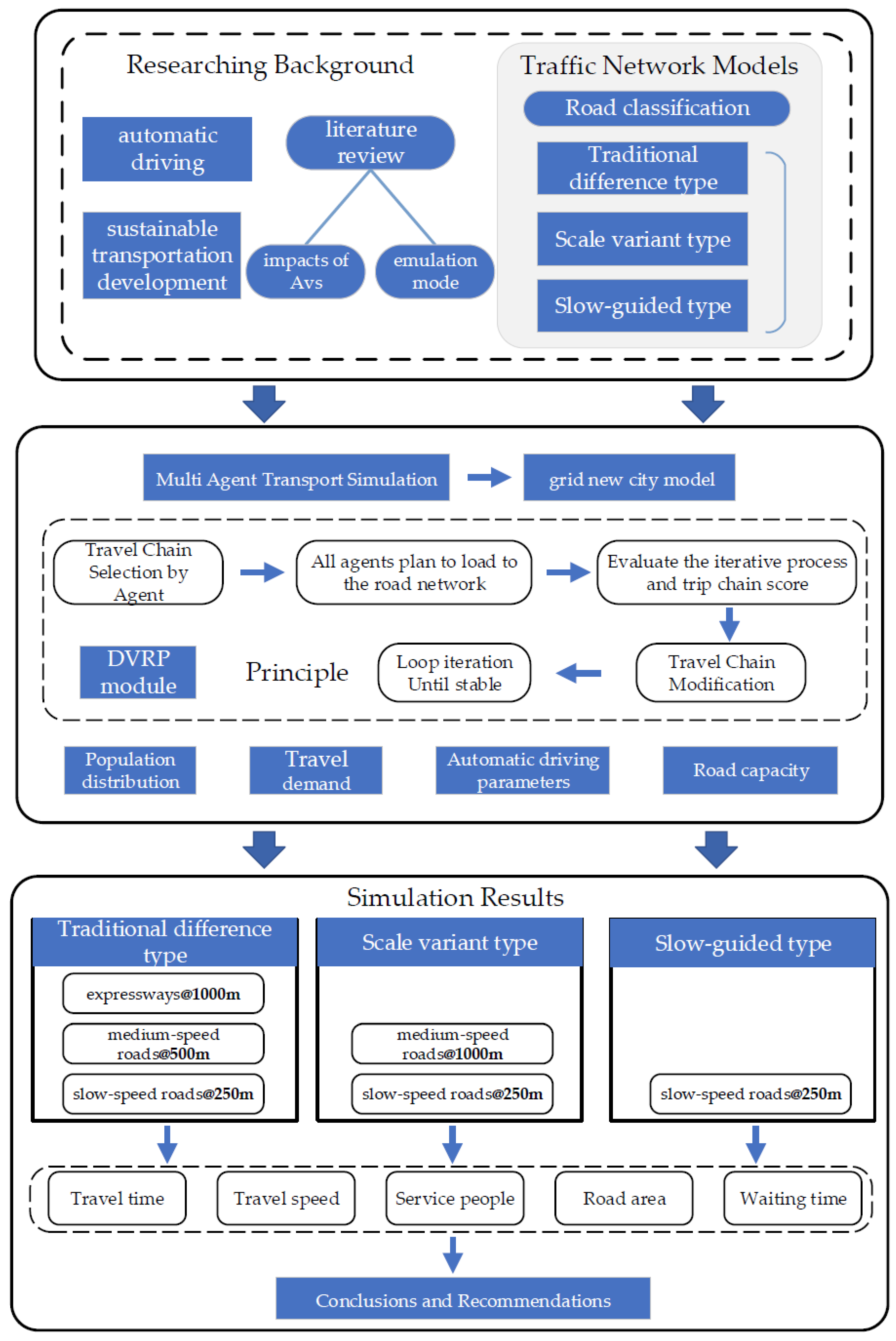
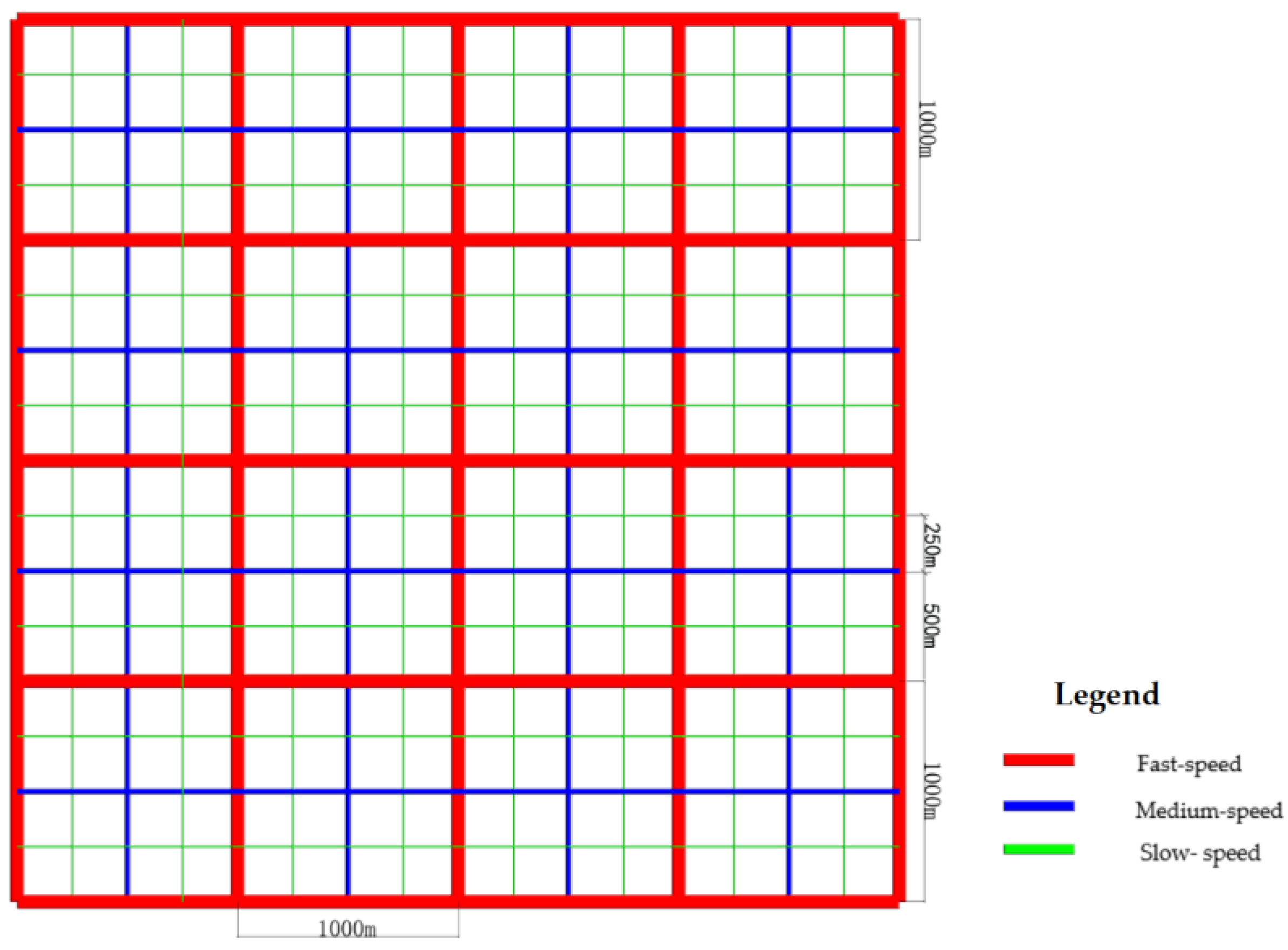
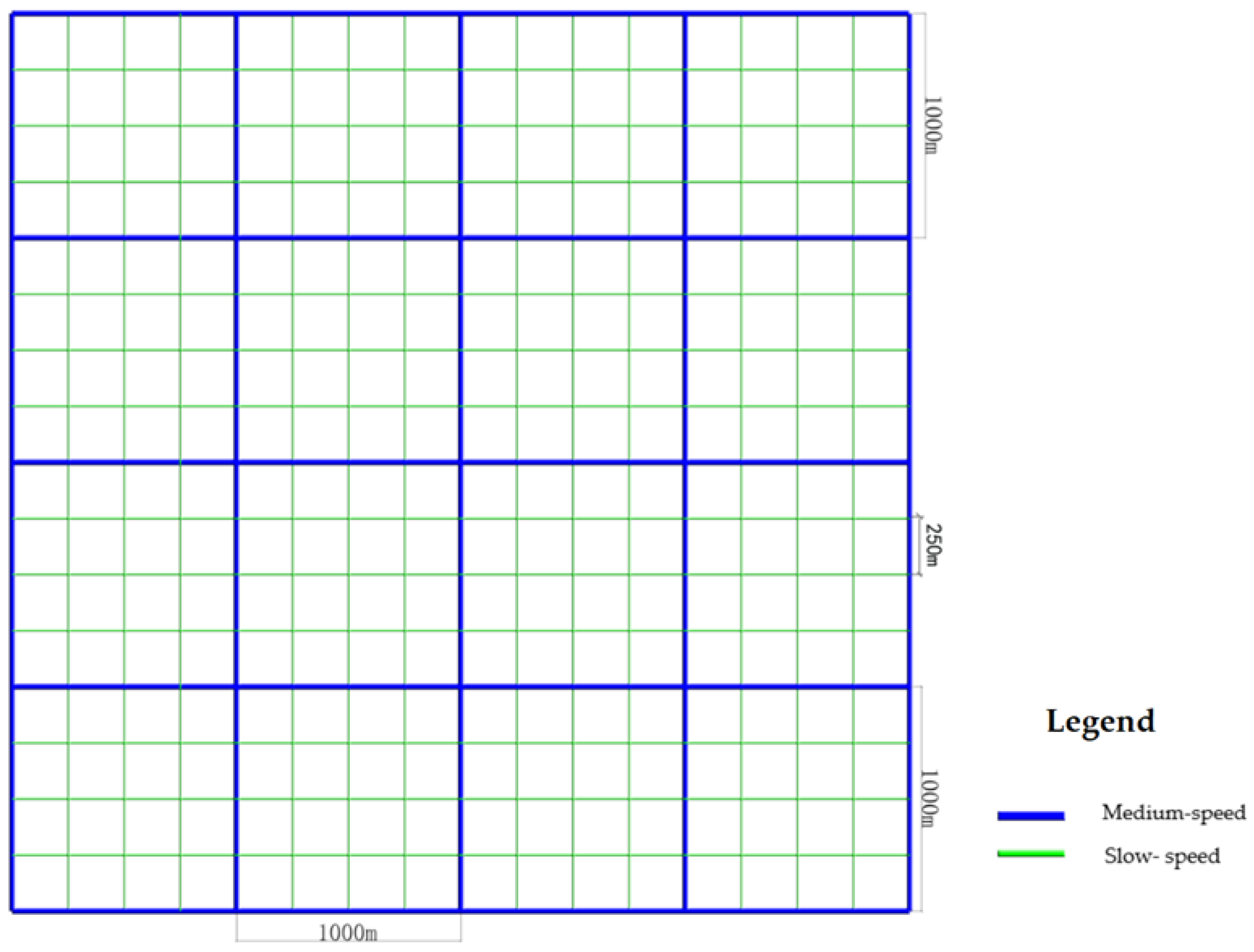


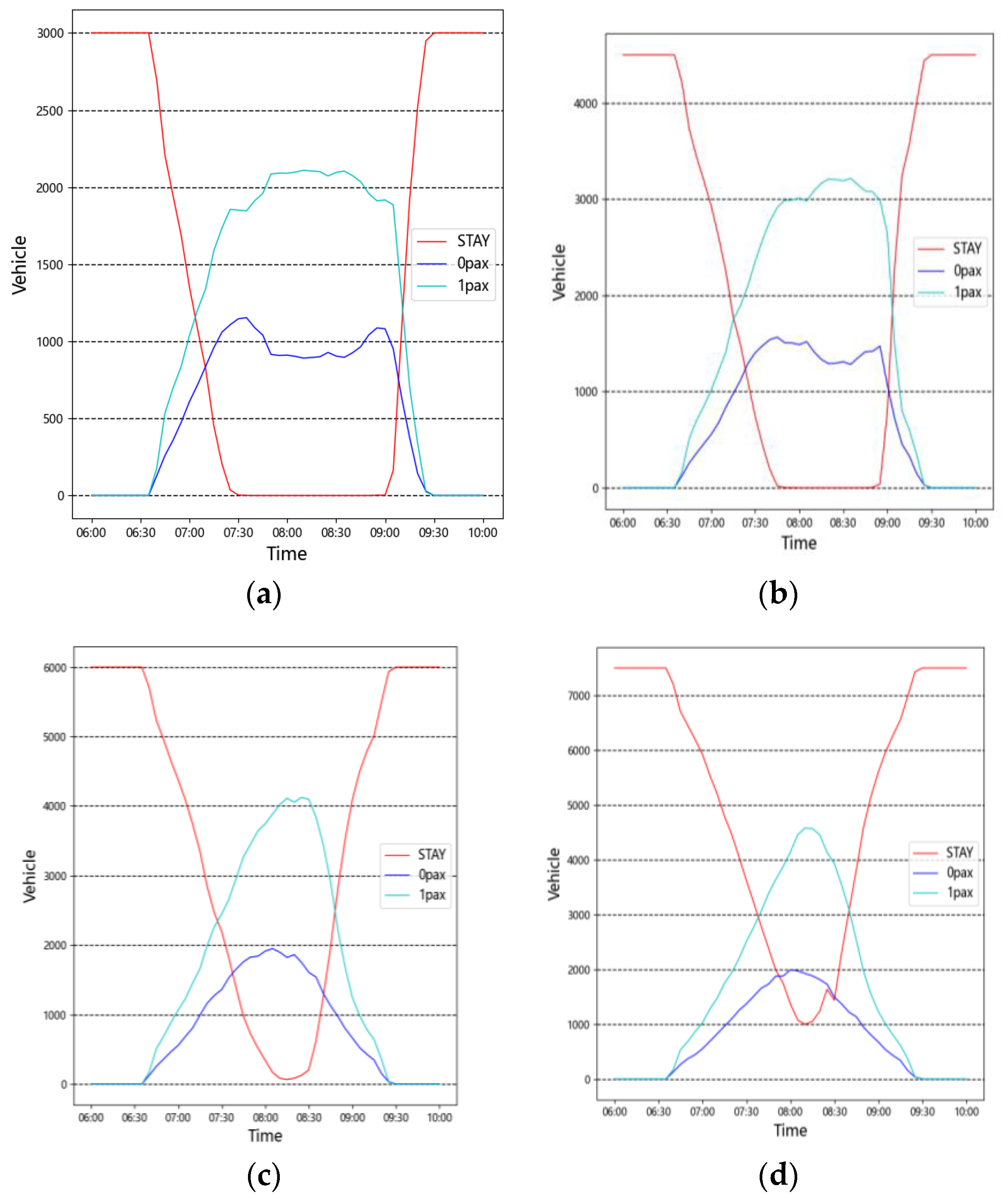

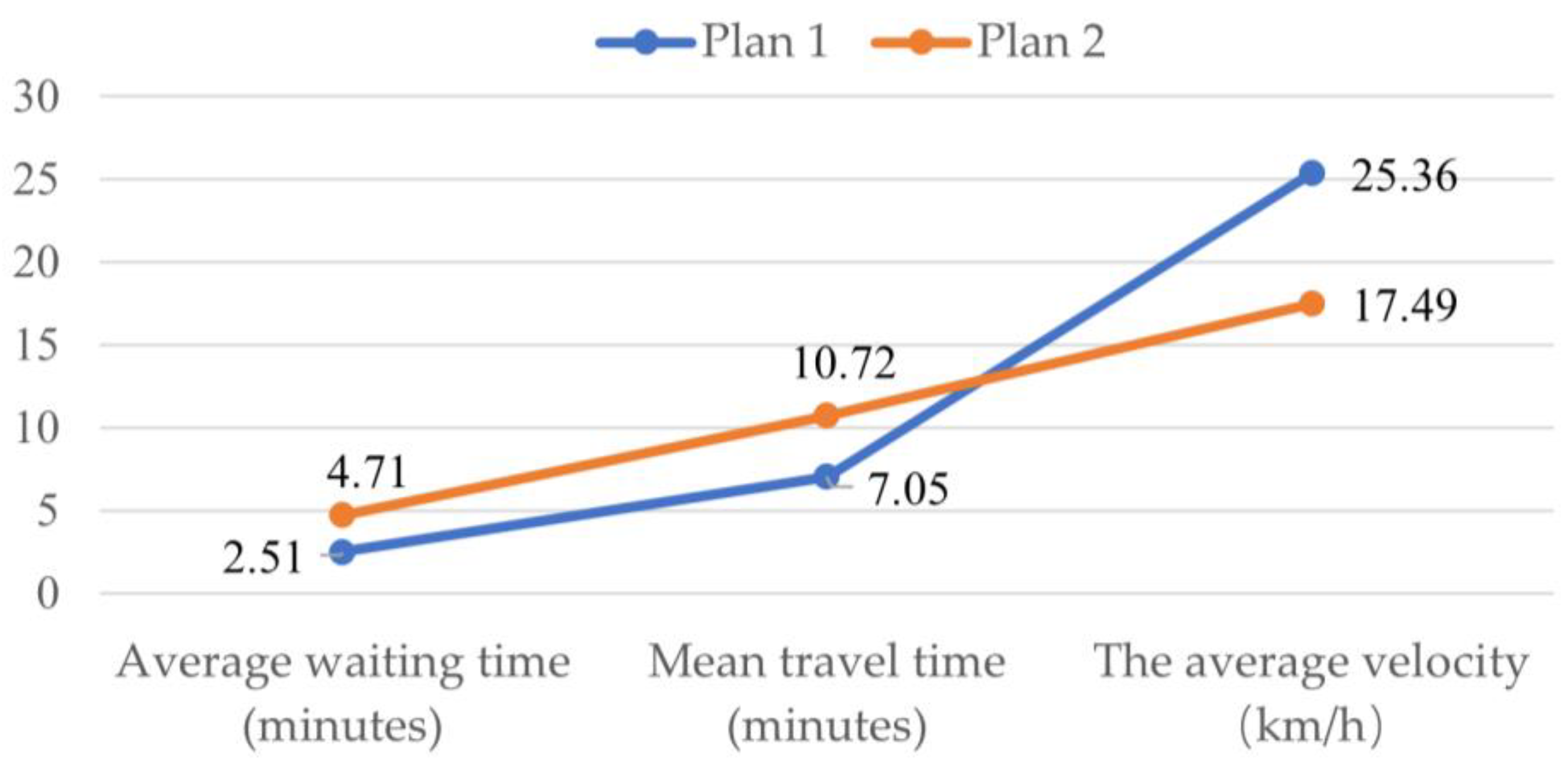


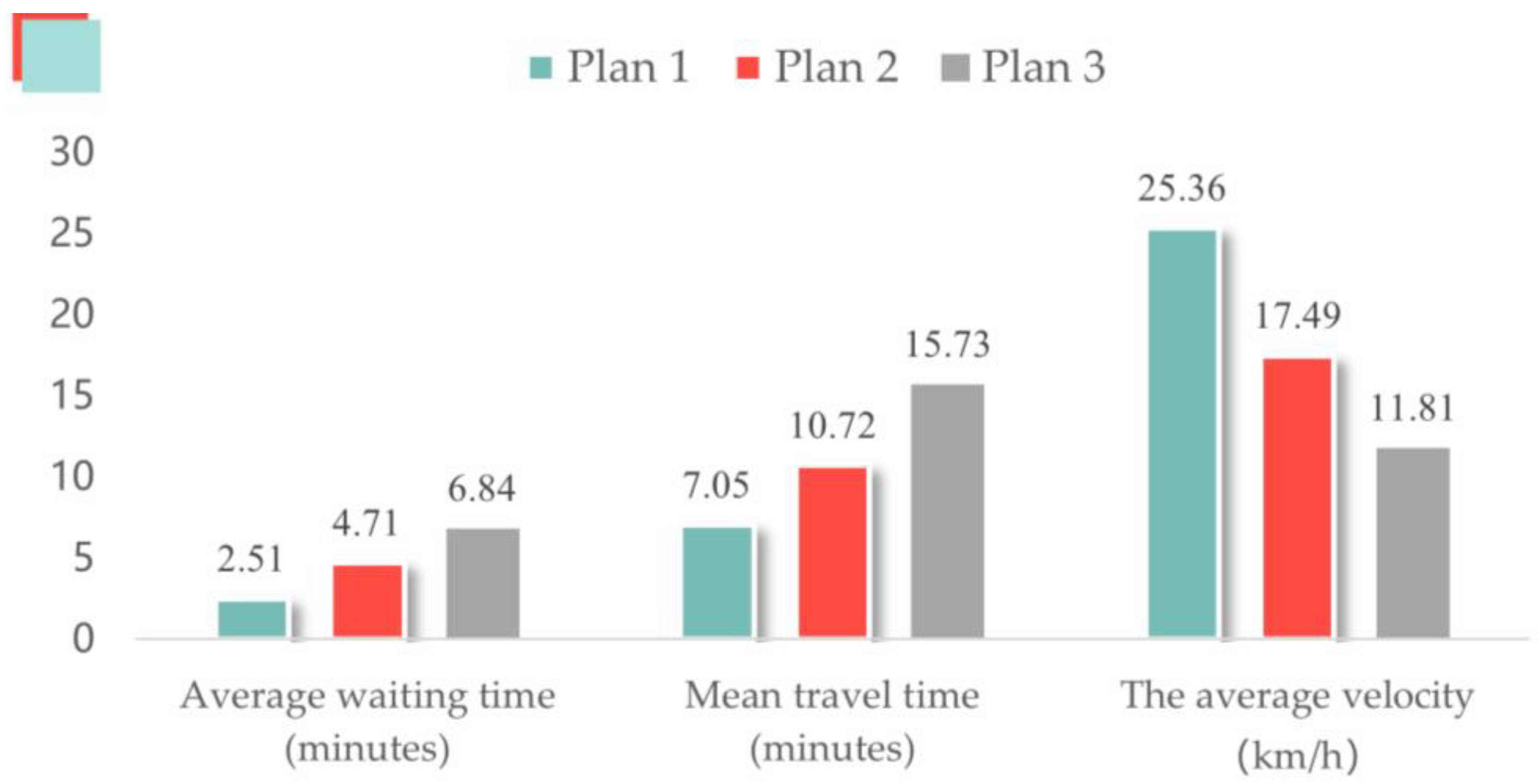
| Models | Network Shape | Road Grade Classification | Road Grade Type | Road Spacing (Meters) | Position | Standard Lane Number (One-Way) | Design Speed (Kilometers per Hour) |
|---|---|---|---|---|---|---|---|
| Traditional difference type | square grid | 3 | expressways | 1000 | underground | 3 | 80–100 |
| medium-speed roads | 500 | ground | 2 | 40–60 | |||
| slow-speed roads | 250 | ground | 1 | 15–20 | |||
| Scale variant type | square grid | 3 | expressways | 1000 | underground | 3 | 80–100 |
| medium-speed roads | 1000 | ground | 2 | 40–60 | |||
| slow-speed roads | 250 | ground | 1 | 15–20 | |||
| Slow-guided type | square grid | 2 | expressways | 1000 | underground | 3 | 80–100 |
| slow-speed roads | 250 | ground | 1 | 15–20 |
| Size of Vehicle Fleet | Number of Service Trips | Average Waiting Time (Minutes) |
|---|---|---|
| 3000 | 64,958 | 6.9 |
| 4500 | 76,898 | 5.75 |
| 6000 | 80,000 | 2.5 |
| 7500 | 80,000 | 1.9 |
| Model | Service Groups | Mean Travel Distance (Kilometers) | Average Waiting Time (Minutes) | Mean Travel Time (Minutes) | The Average Velocity (Kilometers per Hour) |
|---|---|---|---|---|---|
| Traditional driving | 59,832 | 3.16 | 9.36 | 20.98 | 9.04 |
| Autonomous driving | 80,000 | 3.08 | 2.51 | 7.05 | 25.36 |
| Model | Service Groups | Mean Travel Distance (Kilometers) | Average Waiting Time (Minutes) | Mean Travel Time (Minutes) | The Average Velocity (Kilometers per Hour) |
|---|---|---|---|---|---|
| Traditional driving | 55,441 | 3.24 | 9.6 | 23.2 | 8.29 |
| Autonomous driving | 79,392 | 3.13 | 4.71 | 10.72 | 17.49 |
| Model | Service Groups | Mean Travel Distance (Kilometers) | Average Waiting Time (Minutes) | Mean Travel Time (Minutes) | The Average Velocity (Kilometers per Hour) |
|---|---|---|---|---|---|
| Traditional driving | 46,610 | 3.13 | 10.07 | 27.35 | 6.87 |
| Autonomous driving | 69,325 | 3.10 | 6.84 | 15.73 | 11.81 |
| Transportation Network Scheme | Model | Service Groups | Area of Motor Vehicle Lane (Square Kilometers) | Proportion | Mean Travel Distance (Kilometers) | Average Waiting Time (Minutes) | Mean Travel Time (Minutes) | The Average Velocity (Kilometers per Hour) |
|---|---|---|---|---|---|---|---|---|
| Plan 1 | traditional driving | 59,832 | 1.46 | 9.10% | 3.16 | 9.36 | 20.98 | 9.04 |
| autonomous driving | 80,000 | 1.04 | 6.50% | 3.08 | 2.51 | 7.05 | 25.36 | |
| Plan 2 | traditional driving | 55,441 | 1.23 | 7.70% | 3.24 | 9.6 | 23.2 | 8.29 |
| autonomous driving | 79,392 | 0.88 | 5.50% | 3.13 | 4.71 | 10.72 | 17.49 | |
| Plan 3 | traditional driving | 46,610 | 0.95 | 5.95% | 3.13 | 10.07 | 27.35 | 6.87 |
| autonomous driving | 69,325 | 0.68 | 4.25% | 3.10 | 6.84 | 15.73 | 11.81 |
Disclaimer/Publisher’s Note: The statements, opinions and data contained in all publications are solely those of the individual author(s) and contributor(s) and not of MDPI and/or the editor(s). MDPI and/or the editor(s) disclaim responsibility for any injury to people or property resulting from any ideas, methods, instructions or products referred to in the content. |
© 2023 by the authors. Licensee MDPI, Basel, Switzerland. This article is an open access article distributed under the terms and conditions of the Creative Commons Attribution (CC BY) license (https://creativecommons.org/licenses/by/4.0/).
Share and Cite
Wang, D.; Sun, T.; Xie, A.; Cheng, Z. Simulation Study on the Coupling Relationship between Traffic Network Model and Traffic Mobility under the Background of Autonomous Driving. Sustainability 2023, 15, 1535. https://doi.org/10.3390/su15021535
Wang D, Sun T, Xie A, Cheng Z. Simulation Study on the Coupling Relationship between Traffic Network Model and Traffic Mobility under the Background of Autonomous Driving. Sustainability. 2023; 15(2):1535. https://doi.org/10.3390/su15021535
Chicago/Turabian StyleWang, Dengzhong, Tongyu Sun, Anzheng Xie, and Zhao Cheng. 2023. "Simulation Study on the Coupling Relationship between Traffic Network Model and Traffic Mobility under the Background of Autonomous Driving" Sustainability 15, no. 2: 1535. https://doi.org/10.3390/su15021535
APA StyleWang, D., Sun, T., Xie, A., & Cheng, Z. (2023). Simulation Study on the Coupling Relationship between Traffic Network Model and Traffic Mobility under the Background of Autonomous Driving. Sustainability, 15(2), 1535. https://doi.org/10.3390/su15021535





